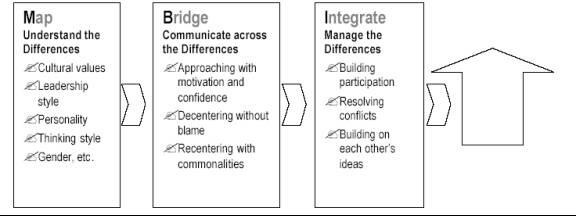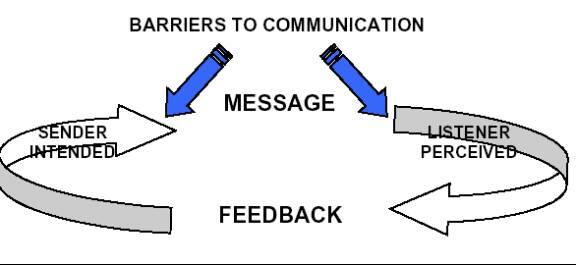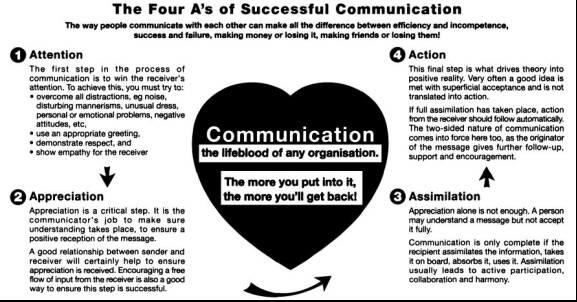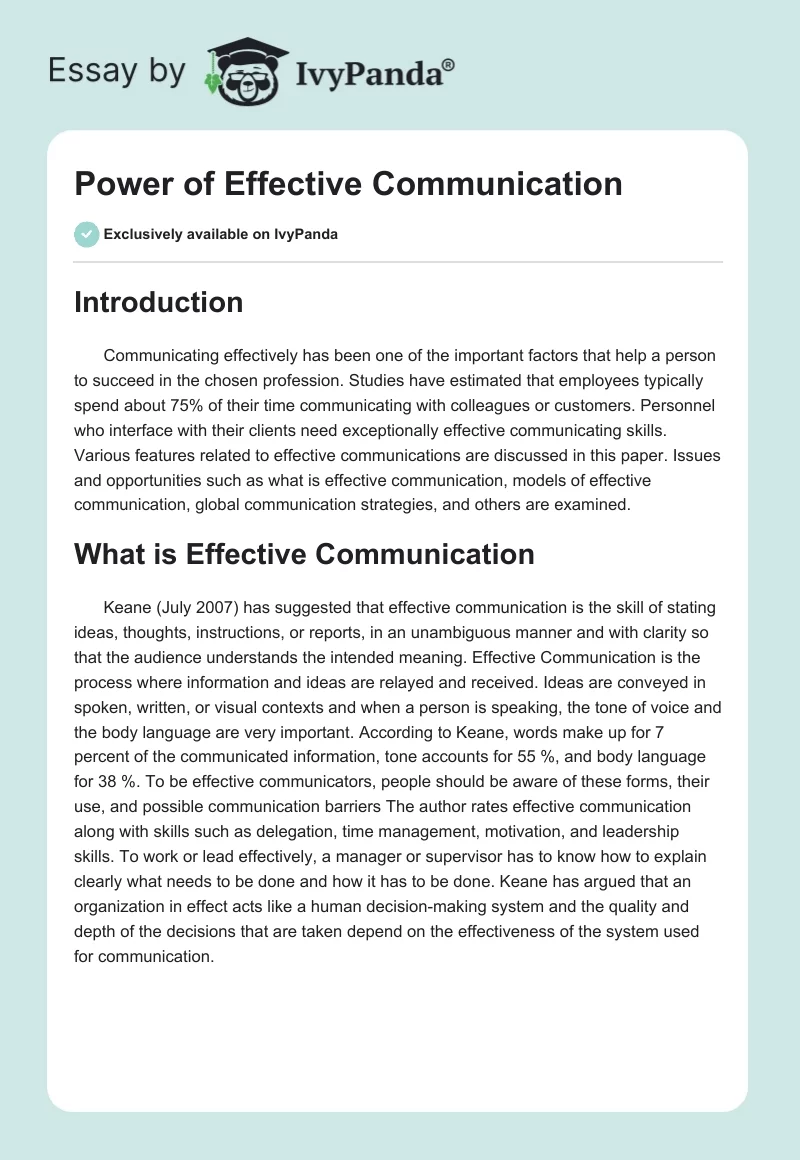Introduction
Communicating effectively has been one of the important factors that help a person to succeed in the chosen profession. Studies have estimated that employees typically spend about 75% of their time communicating with colleagues or customers. Personnel who interface with their clients need exceptionally effective communicating skills. Various features related to effective communications are discussed in this paper. Issues and opportunities such as what is effective communication, models of effective communication, global communication strategies, and others are examined.
What is Effective Communication
Keane (July 2007) has suggested that effective communication is the skill of stating ideas, thoughts, instructions, or reports, in an unambiguous manner and with clarity so that the audience understands the intended meaning. Effective Communication is the process where information and ideas are relayed and received. Ideas are conveyed in spoken, written, or visual contexts and when a person is speaking, the tone of voice and the body language are very important. According to Keane, words make up for 7 percent of the communicated information, tone accounts for 55 %, and body language for 38 %. To be effective communicators, people should be aware of these forms, their use, and possible communication barriers The author rates effective communication along with skills such as delegation, time management, motivation, and leadership skills. To work or lead effectively, a manager or supervisor has to know how to explain clearly what needs to be done and how it has to be done. Keane has argued that an organization in effect acts like a human decision-making system and the quality and depth of the decisions that are taken depend on the effectiveness of the system used for communication.
Models of Effective Communication
Blitefield (2006) has presented a detailed discussion of the process of communication. According to the author, the process of communication has one communicator and at least one or more receivers. Effective communication starts with how completely the communicator can relate the information and how much of the information that is relayed is understood by the receivers. Effective communication between different disciplines has become one key aspect in organizations. In many cases, the communication process becomes complex when the subjects are controversial or there are multiple and diverse teams. The author speaks of the need to bridge the differences and this is one of the most important factors. The author has defined effective communication as the transmission of subjects and meaning between people and minimizing any misunderstand between them. Several models have been proposed for effective communications and some of them are discussed in the next paragraphs.
Robbins (2003) has suggested that the models of effective communication essentially start with a clear understanding of how people bridge their communication differences or the communication gap as it is called. The author argues that people tend to interpret information by using their reference frame and these references have been shaped by cultural backgrounds or group associations. The process of bridging is an try to minimize the inherent differences by trying to understand the reference frame that others are using. The process of bridging again needs to be a two-way process and both the sender and receiver have to attempt to remove any obstacles. The process of bridging the cultural differences among different groups becomes very important in business contexts such as management. Hofstede (1980) had proposed a framework that would help to assess the cultures by identifying 5 important value dimensions of the national cultures. The model was later expanded by other research organizations till no dimensions were identified. Myers (1985) has proposed the Myer Briggs Type Indicator that makes up the personality framework and explains the behavior of individuals and the concepts can be used to explain the different relationships between cultures.
The MBI Communication Model
The Map-Bridge-Integrate model has three interacting components and provides a means to bridge the cultural differences (DiStefano et all, 2002)

Map – Understand the Differences: The Map component is used in describing and understanding any differences between team members and also specifying the impact that these differences have on team objectives. There are three aspects and they are: selecting the characteristics to be mapped; description of members’ characteristics and identification of the impact of the characteristics.
Bridging – Communicate across the Differences: The Bridging component deals with communicating effectively across the group differences to bring ideas and people together. The main aim of this component is to stop miscommunication There are three aspects to this component: preparing and motivating members to build confidence and communicate so that problems are overcome. This is important since there is a possibility that because of lack of motivation, communication may not happen even after the differences are understood. Decentring where the team members try to explain their understanding of the difference in the process of communication by altering their behavior and thought process. This allows other cultures to be accommodated in their understanding. Re-centring is another aspect and team members try to create a new basis on which interactions can be created. A good understanding of differences is required and consent on shared norms has to be agreed upon.
Integrating – manage the Differences: The integrating component ensures that people use their differences to make good decisions. The understanding developed in the mapping component is converted to obtain positive results. There are three aspects for this component and they are: managing the participation to ensure that all members have an equal opportunity to participate by accommodating different norms for participation that would result from cultural differences; resolving disagreements or possible conflicts so that any disputes are addressed before they increase. The mapping component helps to detect early any probable areas and conflict zones while the bridging component helps to make manageable any personal conflicts. The third aspect is the building on ideas which is the final aspect. Individual ideas are taken as the starting point for any discussion and the concept of ownership needs to be left.
Barriers to Effective Communication
McAteer (March 2007) speaks of certain barriers to communication and the author defines barriers as Barriers are factors that break down or impede a continuous relay of information. These barriers tend to disrupt the process and act of communication. The author has suggested several factors that act as barriers and they are: Nonassertive behavior, Task preoccupation, frustration and anger at the communicator, any personal enmity or bias, diversity in the team with little areas of common interest, lack of confidence in self or on the communicator; complex organizational structure, distractions, tunnel vision, external and internal interruptions and so on.

Smith (December 2007) has pointed that two types of major differences create barriers to effective communication and they are: Cultural differences and Group differences. Cultural differences occur when people from different cultures are involved in the communication process. Culture is defined informally as a set of shared traditions, values, and beliefs that control the formation and behavior of different social groups. The author argues that cultures have a strong influence on how people communicate and relate with each other. The cultural differences often create a bias or a barrier between the communicator and the receivers. Group differences on the other hand are due to peer pressure among group members and it is the predominant group mentality that creates a barrier against communication. The author argues that groups can be based according to work natures, ethnicity, and nationality, profession, and gender. Groups can also be formed as per the roles they play such as engineers, doctors, students, teachers, and so on and in many cases, the groups may even form associations. Groups with whom people are associated are called in-groups while groups with which people are not associated are called out-groups. The author suggests that these groups often have their vocabulary, mannerisms, and code of conduct and when one such group tries to communicate with the others, these mannerisms are not carried through and it can result in miscommunications.
How to Communicate Effectively
Taylor (July 2006) has stressed that effective communications have to be a two-way process and begin with the communicator or the sender who would convey the required information necessary. The sender must have to be proactive and ensure that the receiver can understand the information. Certain key factors that need to be followed are: stating one idea at a time; putting forward the ideas in a medium that is understood; take extra care to elaborate and repeat if required, understand the body language of the audience and ask questions now and then to keep them involved in the discussion. Taylor has defined the four A’s of successful communication and they are Attention; Appreciation, Action, and Assimilation. The Four A’s are illustrated in Figure 3.
Attention: this is the first step in the process of effective communication and it deals with getting the receiver’s attention. This can be achieved by: overcoming distractions such as disturbing mannerisms, noise, emotional and attitude problems, negative and sarcastic attitude, and so on; using an appropriate greeting, showing respect and empathy for the people

Appreciation: Appreciation is a critical step and it is the responsibility of the communicator to ensure that understanding takes place and that there is a positive reception of the message. A good relationship between the sender and the receiver will help to ensure that appreciation is received. Encouraging a free flow of input from the receiver is also a good way to ensure that this step is carried out properly.
Assimilation: This is the third step and though a person understands a message, it may not be accepted fully. Communication is considered only after the recipient assimilates the information, takes and uses it. It leads to active participation, collaboration, and harmony.
Action: This is the final step and moves the theory of communication into reality. In some cases, a good idea or a meaningful message is accepted superficially but is not translated into action. If complete assimilation takes place, the action from the receiver has to follow. A two-sided communication is brought into action and results in the required activity.
Effective Communication in the Global Context
Yates (et all, 2006) have stressed the importance of effective communication for organizations that operate globally. Such organizations operate in different time zones and have employees who have different backgrounds and nationalities. In such a scenario, a proper communication strategy has to be in place to ensure that the messages given out by management are not distorted and the true intent is assimilated. The authors surveyed some leading global organizations to understand how they managed the communication strategy. They used a survey instrument to identify the best practices and the response percentages are shown in Figure 4.

The study showed that only about 18% of the organizations had an established and documented global communication strategy. What many enterprises are learning is that the traditional approach to global communication – translating messages into several languages and shipping them to local managers for dissemination – simply doesn’t work. This approach often results in messages that are misunderstood, miscommunicated, and sometimes not communicated at all. Several multinationals have recognized the value of bringing a global perspective to their communication strategies. The author has reported several steps that such companies are taking up and they are:
Getting global participation: One of the biggest challenges in developing a global strategy is ensuring that the strategy supports and drives corporate goals without overlooking the distinct needs of separate regions, countries, and business areas. Inputs from people around the world are needed to strike the right balance (Maznevski, M. L., 1994).
Making global teams effective: Enterprises that put together effective global teams to develop and maintain the communication strategy are achieving some very positive results. The keyword here, though, is effective. Research into the performance of global teams – and this is not just global communication teams – shows that such teams don’t always deliver the value the enterprise expects. Cultural differences represented in multicultural teams provide great potential for creating value.
Creating messages with a global appeal: Global input provides insight into cultural sensitivities, compliance and legislative differences, and the unique characteristics of each market. Effective communicators use this insight to craft messages that are easy to interpret, translate and adapt to local needs. They also look at the type and content of messages to determine how widely they need to be communicated. The best global communicators determine which messages cannot be tinkered with and which areas of content are open for local customization. Moreover, they make it clear to local managers, which messages must be delivered exactly as presented and which ones can be adapted or expanded to address local needs.
Training local managers to communicate: While some multinationals have dedicated internal communicators on a regional basis, some of them have dedicated communicators on a country or local basis. Some companies rely on local managers to interpret and deliver messages. Functionally, these managers might be responsible for HR, plant management, or operations, so they often don’t have expertise in communication. Unfortunately, few companies provide training and support for these local managers and fewer still have processes in place to ensure that messages were delivered and understood.
Choosing the right delivery mechanisms: Effective internal communicators take advantage of a variety of media and technologies to communicate corporate messages. Options enable local managers to select the tools and information that work best for local employees. Face-to-face presentations work better in some parts of the world, while self-learning tools work better in others.
Measuring success: There are a variety of ways to measure, from focus groups and comprehensive annual employee surveys to quarterly targeted surveys, short feedback questionnaires for forums and workshops, and phone calls to local managers and employees. Such activities help to keep a pulse on whether or not people are receiving, understanding, and embracing messages. As the measurement processes are developed, the ultimate goal should be to identify the links between communication effectiveness and improved productivity and business performance.
Conclusion
The paper has discussed various issues related to effective communication. Effective communication is the process where the exchange of information takes place clearly and unambiguously. Global companies are facing an increasing challenge in inputting into a place an effective communication strategy that would reach employees from different cultural backgrounds.
References
Blitefield Jerry. (2006). The Rhetoric of RHETORIC: The Quest for Effective Communication. Journal of Rhetoric & Public Affairs. East Lansing. Volume 9. Issue 4. pp: 710-714.
DiStefano, J. J. Ekelund, B. Z. (2002). The MBI Model of Managing Differences Effectively. In Heritage & Management: Identity as a Competitive Tool, J. M. Fladmark (ed.), Donhead Publishing, Edinburgh.
Hofstede, G. (1980). Cultural Consequences: International Differences in Work-Related Values. Sage, Beverly Hills, CA.
Keane Tess. (2007). Power of effective communication. Nursing Standard: Harrow on the Hill. Volume 21. Issue 45. pp: 78-80.
Maznevski, M. L. (1994). Synergy and Performance in Multicultural Teams, Ph.D. dissertation. The University of Western Ontario.
McAteer Teal. (2007). Strategic Organizational Change. Canadian Journal of Administrative Sciences. Halifax. Volume. 24. Issue 1. pp: 74-76.
Robbins, S. P. (2003). Organizational Behavior. Prentice-Hall, Upper Saddle River, NJ.
Smith Marolee Beaumont. (December 2006). A Study on South African Corporate Business Failures. Journal of The Business Review, Cambridge. Hollywood. Volume 6. Issue 1. pp: 168-173.
Taylor Shirley. (2006). Communicating across Cultures. The British Journal of Administrative Management. Orpington. pp: 12-15.
Yates Kathryn. Beech Roger. (2006). Six crucial steps to effective global communication. Journal of Strategic Communication Management. Chicago. Volume 10. Issue 5. pp: 26-30.


